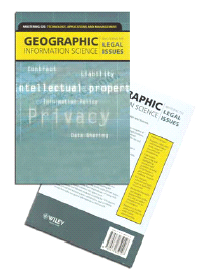Cho, George (2005) Geographic Information Science: Mastering the Legal Issues, West Sussex, England, John Wiley & Sons: ISBN: 0-470 85009-4 (HB); 0-470-85010-8 (PB) 440 pgs including Index: Pound sterling 65 (hard back) and 24.95 (PB)
Prof Cho has written this book devoted to an exploration of the many legal issues impacting the development and application of GIS. This book is a part of a John Wiley “Mastering GIS: Technology, Applications and Management” series.
The book is comprised of six very substantial chapters. Chapter One looks at geographic information science, law and policy issues. Recognising that many readers of this work will be non-lawyers, the author provides a very useful introduction to law and the legal system and the nexus between geographic information and law. Chapter Two is entitled: “Sharing Geographic Information System”.
The chapter examines the policies on access to public sector information as developed by Australia, NZ, United States, and the European Union. The author notes that we are moving towards a global information infrastructure and adoption of common standards. In this discussion, Asia-Pacific and Canadian Geospatial standards are also mentioned. This chapter emphasises an important theme of the book and a major reason the work is so valuable and impressive. GIS technology today often transcends national boundaries. Moreover, countries around the world are competing to develop the most suitable regulatory framework that will achieve an appropriate balance between the needs of government, developers, users and other groups impacted by GIS technology. This comparative/international dimension requires extensive research across diverse legal systems. That Prof Cho not only achieves this but also presents the information in a clear, interesting and highly readable manner is a major accomplishment.
Geographic information is valuable and when married to GIS the economic value multiplies greatly. In this environment an understanding of intellectual property rights is essential and comprises the topic of Chapter Three. Again, we see the comparative international dimensions as most countries in the world have been impacted by developments of the World Intellectual Property Organisation (WIPO) and World Trade Organisation (WTO) negotiations that have made compliance with intellectual property requirements a pre-condition to WTO membership.
For citizens, the rapid growth and development of GIS use means that privacy is increasingly difficult to protect. Thus Chapter 4 deals with this important topic, again from the perspective of different countries, including the US, EU and Australia
As a billion dollar plus industry, the commercialisation of GIS is also an important topic. Commercialisation aspects are covered in Chapter Five. This chapter focuses on contract law, including electronic contracts. Increasingly GIS services are provided over a networked environment. This means that developments in cyberlaw (for example, the enforceability of electronic contracts) become quite important. These are discussed in this chapter together with excellent case examples and practical checklists— these features being major selling points of the work which add greatly to its readability and usefulness.
Today we live in an Information Age. But what happens if the information is incorrect and people get harmed as a result. For example, what if a map is incorrect and as a result a plane crashes causing death. The final chapter thus examines the legal standards and guidelines that govern legal liability in relation to GIS. Appropriately, Prof Cho discusses these issues within a broader context of risk management.
A special feature of this book is its student-friendliness. Summaries, learning objectives, size of print and layout all make the book very ‘user-friendly’. For the researcher wanting to go deeper, the work is also amply footnoted and referenced, including references to useful websites. The checklists and frequent use of case studies to illustrate the application of the law are also commendable. The only thing missing that would have been useful is a good glossary of terms.
In summary, I think this is an impressive, substantial, important and very accessible work. It will be of great use to those operating in the GIS industry, lawyers, government employees, consumer groups and policy makers alike. I am confident that this second book on GIS and the Law by Prof Cho will prove to be even more popular and useful than the first.








 (5.00 out of 5)
(5.00 out of 5)





 (5.00 out of 5)
(5.00 out of 5)





 (5.00 out of 5)
(5.00 out of 5)





 (5.00 out of 5)
(5.00 out of 5)